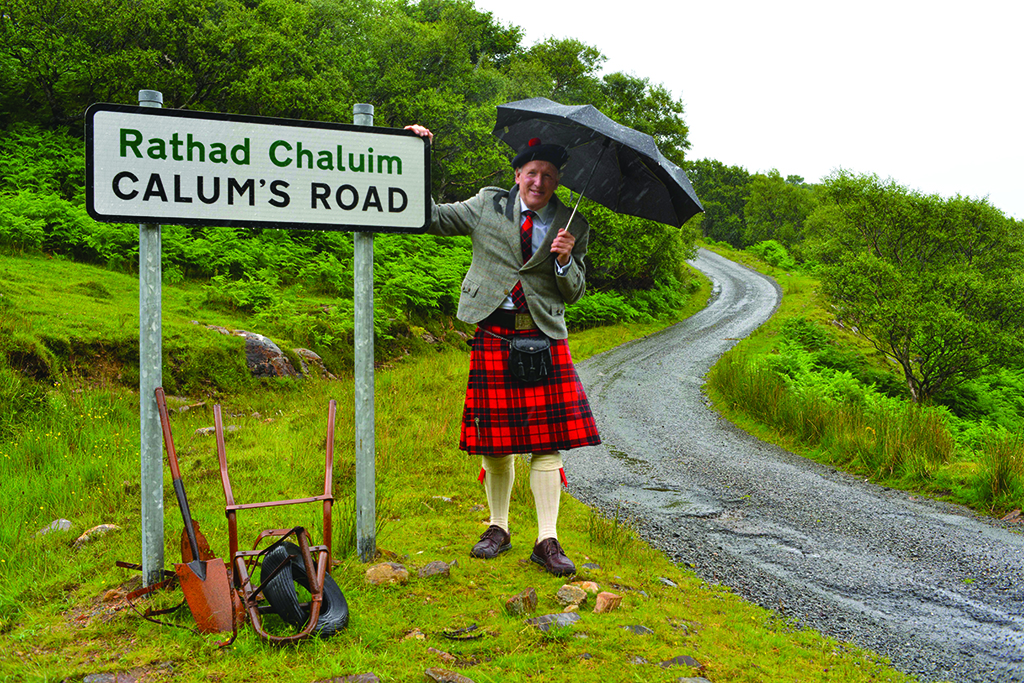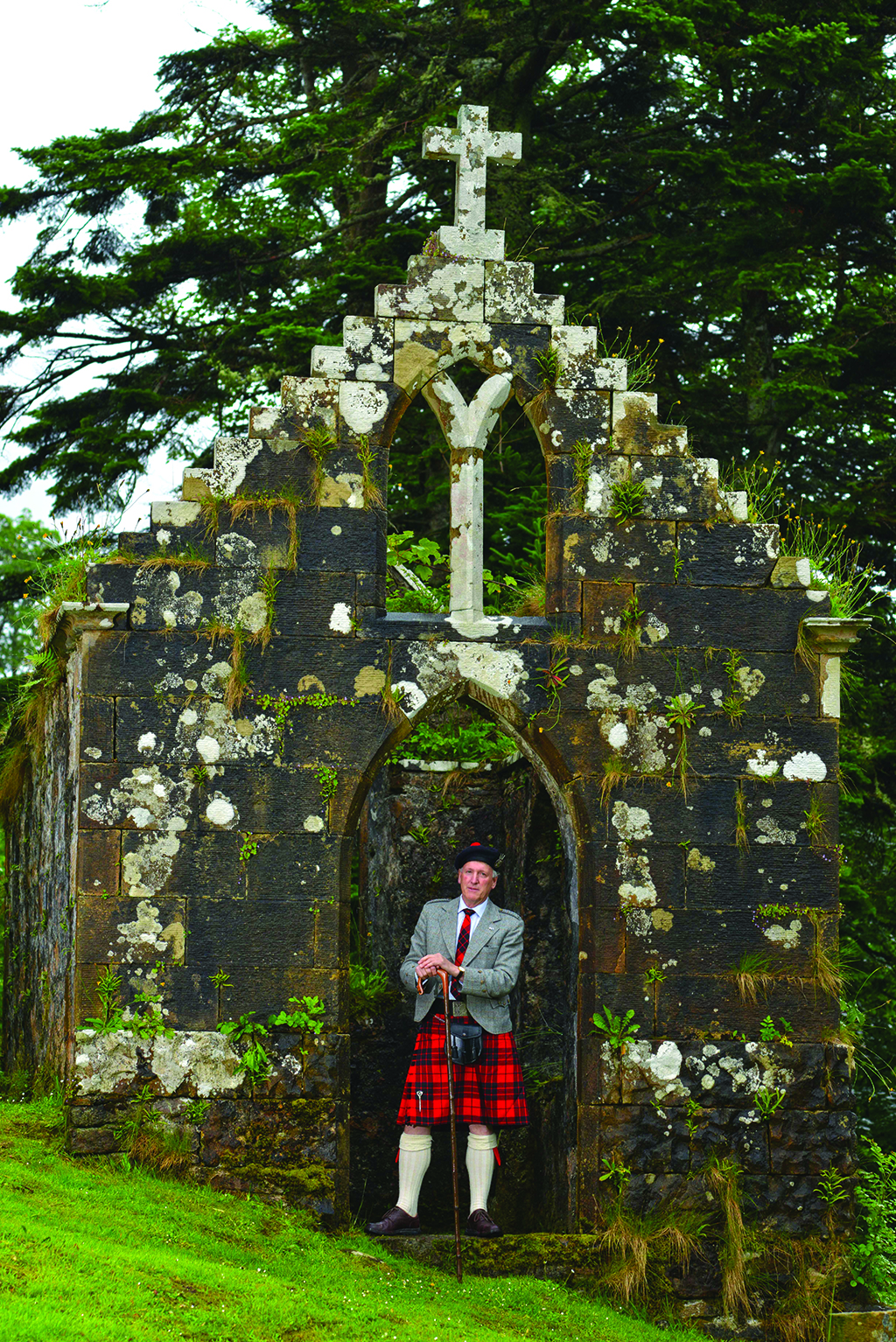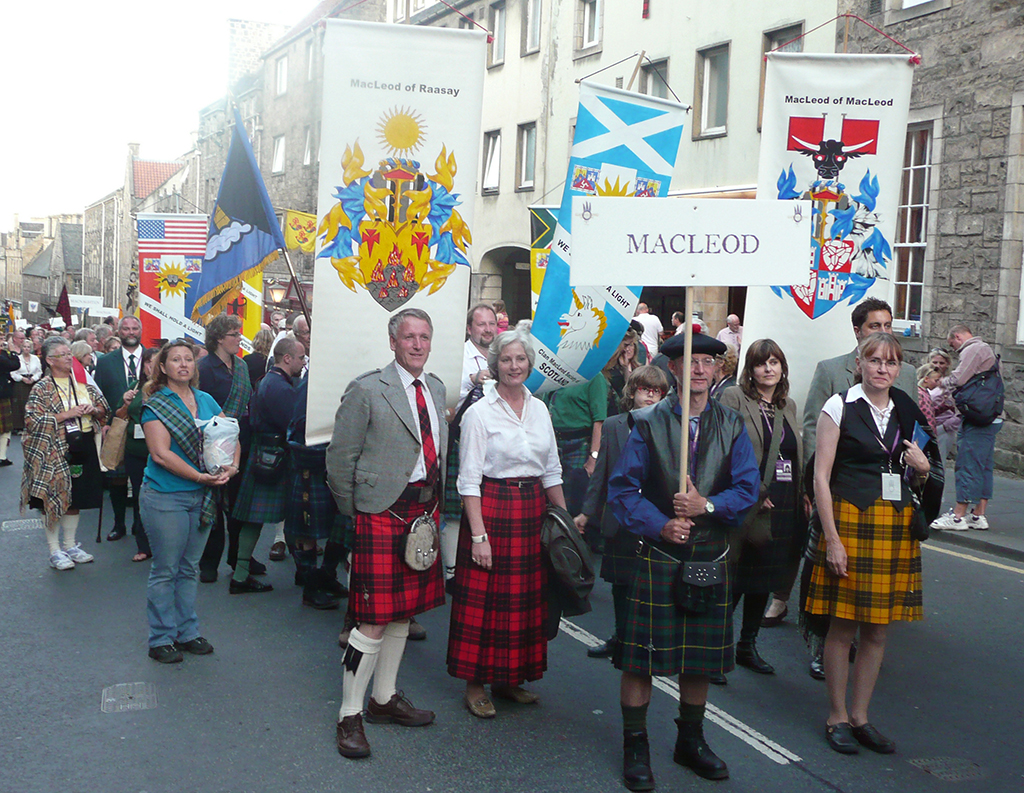
The Scottish clan that has risen from the ashes
Chief John Macleod of Raasay manages to keep up-to-date with island life, despite living ten thousand miles away.
With the distinctive basalt ‘chimney’ of Dùn Caan framing the spectacular Hebridean seascape from the mainland, the Isle of Raasay lies just a mile off Portree, the Isle of Skye’s capital town.
As well as being the birthplace of Sorley MacLean, the celebrated Scottish Gaelic poet, the island has a rich and turbulent history and is deeply invested in its MacLeod chiefs.
Since succeeding his father in 2001, John Macleod has taken his role as Chief of the Macleods of Raasay very seriously, despite the fact that he lives ten thousand miles away. When Dame Flora MacLeod of MacLeod visited Tasmania on her tour of the Commonwealth to establish MacLeod societies in 1956, John was only six.
It was his first encounter with ‘Macleodry’. Today ten countries have clan MacLeod societies, many approaching their 60th anniversaries. John remembers very little of Dame Flora’s visit, but does recall playing with an unusual silver brooch. It belonged to his father then, and today adorns John’s bonnet, the chief ’s badge of ‘a sun in splendour’.
John first visited the island of his ancestors and their home, Raasay House in 1977. ‘The house was all boarded, but it had a magnificent feel to it,’ he recalls. ‘It sounds strange but I had a very odd feeling; I sensed that I was coming home.’
The Macleods of Raasay descend from the MacLeods of Lewis. In 1571 the chief Roderick Macleod of the Lewes awarded his second son with the Royal Charter for the lands of Assynt in Sutherland and the islands of Raasay and Rona. It is believed that after the Battle of Carbisdale in 1650, the defeated Marquis of Montrose sought refuge with the wife of Neil MacLeod of Assynt at Ardvreck Castle, but she betrayed him to the Marquess of Argyll.
Neil had been the last Macleod chief to hold lands in Assynt. His death effectively created the island MacLeods of Raasay; they were all that was left.
‘The great thing about Raasay is that it is a one clan island, unlike Skye, which was of course all split up.’ The first Macleod seat on Raasay was Brochel Castle, the impregnable stronghold on the island’s north-eastern coastline. Built in the late 15th century, the castle rises out of the gneiss some twenty metres high, looking as though it had grown out of the rock. As a ruin today it is hard to tell where the rock ends, and medieval masonry begins. Its strategic position controlled the Inner Sound and gave protection from mainland raiders, making invasion only accessible from the much more treacherous seaward approaches.

After years of campaigning for the council to build a road to the north of the island, Calum MacLeod took it upon himself to do so armed with only a shovel, pick and wheelbarrow over a period of ten years (Photo: Angus Blackburn)
But by 1671 and in calmer times, the castle had been abandoned in favour of the fertile southern end of the island, the site of Raasay House.
The Macleods of Raasay’s support for Bonnie Prince Charlie’s Jacobites during the 1745 rebellion would prove disastrous. ‘We came out for the ’45 when the Dunvegan and Harris MacLeods didn’t,’ recounts John with more than a hint of pride. After receiving a letter from the prince, which is now displayed in Eilean Donan, the chief of the day, Malcolm, took 100 men from Raasay to join the fray at Culloden.
In what can now only be seen as a triumph of hopeless loyalty over realism, he handed over the lands and estate to his eldest son John in an attempt to protect the Macleod line, and left to support the hopeless Jacobite campaign.
It proved to be prescient. The battle that would mark the end of Gaeldom, and change clan and Highland life forever, lasted only 45 minutes. Malcolm did survive, but more than 1,500 other Highlanders were not so lucky. Only 50 Hanoverian troops were killed that day on April 16 1746 on the Drumossie Moor.
To compound their woes, our Macleods harboured the fleeing prince on the island for two days whilst government troops hunted for him. The islanders would pay dearly for their loyalty.
‘The island was ravaged by The Duke of Cumberland’s merciless retribution visited upon so many Jacobite strongholds. Government
troops burned down every house on the island, including Raasay House.’ says John. ‘There were about 1,000 people living here, so up to 300 houses were looted and razed, all the livestock killed and boats sunk.’ It was devastating, but with true island stoicism this hardy community picked itself up and rebuilt.
Not so long afterwards, in 1773, James Boswell wrote fondly of his stay on the island and the newly finished Raasay House. ‘Our reception exceeded our expectations. We found nothing but civility, elegance, and plenty.’ John suspects this may have something to do with ‘Old Mr Malcolm M’Cleod’s’ ten daughters, whom he mentions several times.
1838 saw the end for the Macleods on Raasay. The threat of famine and the allure of new and fertile lands abroad became too tempting. As Lord Macdonald of Sleat wrote in his diaries: ‘Emigration fever has gripped this land.’
‘My great, great grandfather, Francis, sold up and emigrated to South Australia with his four brothers, sister and mother,’ relates John.
One brother, Loudoun Hastings Macleod, took up a pastoral lease called Nalang, near Bordertown, where the whole family eventually settled.
‘He was a pioneer of Australian development and opened up the territory around Bordertown,’ recounts John with a glimmer of pride. ‘He is our most distinguished Macleod.’ But alas, Nalang was short lived. Following the death of Francis and his wife Alice, their orphaned children were sent to live with their maternal grandparents in Tasmania; and so the Tasmanian leg of the Macleod of Raasay story begins.

The Macleod chapel is dedicated to a chief’s daughter who died in 1839, and is where John installed a plaque dedicated to the memory of his father in 2004 (Photo: Angus Blackburn)
In 2006 John returned to Nalang, now owned by the Hunt family since 1911. In an act of pride and respect for his lineage he raised the funds to have the gravestones of John Macleod, 13th Chief of Raasay and his sister-in-law Alice Fenton restored and moved into the gardens of Nalang House.
‘We took a GPS location of the graves so we know exactly where their bodies lie.’ says John. ‘Some people might think moving the headstones sacrilegious, but they were buried in a field and would eventually have been lost.’
‘My grandfather paid little attention to his chieftain’s role, but my father Torquil took it much more seriously. Every 200 years chiefs are required to prove their lineage to the Court of the Lord Lyon. Ours hadn’t been done since 1778. So in 1988 my father took on the task of producing all the marriage and birth certificates to prove he was the oldest surviving son of that line,’ John says.
When he first visited the island in 1977, he met Calum MacLeod of Calum’s Road fame. ‘He asked me if I was Torquil’s son,’ says John. ‘I was delighted to learn that they all knew who I was and that their chief existed in Tasmania.’ He hasn’t missed a Clan Parliament, hosted by Dunvegan Castle every four years, since becoming chief.
After the founding of the Raasay House Community Company and purchase of the derelict house in 2007, John has visited just about every year. ‘This was the home of my ancestors and I wanted to be a part of it,’ he says with some emphasis. It is clear that he feels a real sense of responsibility for the island. ‘Because I don’t live here I can’t actually become a member of the community company, so they offered me the role of patron. I was thrilled and happily took on the task.’
It has been an uphill battle and the magnificent outcome really is a testament to the robust community on Raasay. After a £4 million renovation, and only a few weeks away from reopening, the house was partially gutted by a devastating fire in 2009.
Following nine months of negotiating with insurers, work re-commenced only for the building company to go bankrupt.

In 2009, 8000 MacLeods gathered in Edinburgh to march down the Royal Mile
‘The community did a phenomenal job. It’s been very hard on them and the directors. I give them full credit… In 1746 the house was burned down, but arose from the ashes – and you could say the same thing happened again in 2009.’
Raasay House finally reopened its doors in April 2013 and John, Elizabeth, their daughter Hannah and son Alastair were all there to join in with the celebrations. The house now welcomes guests to the hotel, cafe, and outdoor activity centre. It holds ceilidhs, weddings, book festivals, conferences and more, winning high praise from tourists and visitors at every level.
John’s role as chief has taken him all over the world, he has attended gatherings in New Zealand, Australia, North America and Great Britain.
The MacLeods hosted the Highland Games in Aberdeen, NSW, and Charleston, USA, in 2015, which attracts 10,000 visitors each year.
‘The most memorable was the Edinburgh clan gathering in 2009,’ recalls John. ‘Alongside my fellow chief Hugh MacLeod of MacLeod we marched 8,000 clansfolk down the Royal Mile, a modern day equivalent of leading your clan to battle.’
‘I feel very lucky that we can visit the island. We’ve got to know everyone and they are always welcoming. But we can’t come to this house and look at the family portraits, there just aren’t any. I am searching the globe for Raasay artefacts.’
But the search and the story goes on. This 21st century chief seems to have inherited the intrepid spirit of his ancestors.
This feature was first published in 2016.
TAGS

